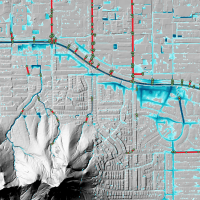Video
Is rain-on-grid modelling accurate?
Rain-on-grid (or direct rainfall) modelling is quick and easy to setup, but is it accurate and what are the pitfalls?
About
Direct rainfall or rain-on-grid modelling first appeared on the hydraulic modelling landscape in the mid-2000s using TUFLOW as an easier way to model rainfall-runoff in Sydney’s urban environments instead of the traditional, and somewhat tedious approach of delineating sub-catchments for a hydrologic model.
However, there has been very little demonstrating of fit-for-purpose through calibration to historic data with many modellers running blind as to whether their modelling is representative of the real-world. Whilst hydrologic models remain substantially faster, improvements to 2D solvers and GPU acceleration continue to make products like TUFLOW increasingly viable options for simulating the rainfall-runoff hydrologic process due to their faster model setup times and more visual result presentation formats for stakeholders.
Join this webinar to learn about the accuracy of direct rainfall modelling based on benchmarking and calibration to historic data sets, and how new features in TUFLOW’s 2020 release have substantially overcome previous shortcomings of 2D hydraulic solvers for rain-on-grid modelling.





